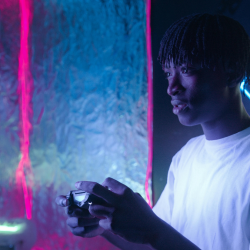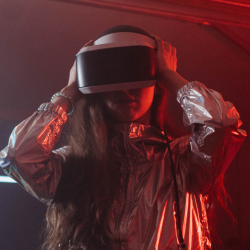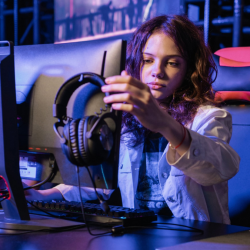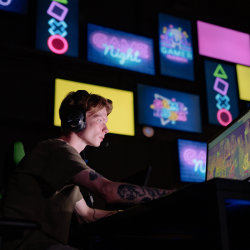Gaming strategies hold huge cultural power for brands…
But if we want to play, we need to look beyond the mainstream for resonance with the full gaming community. The cinematic and widely anticipated (although allegedly unplanned) release of Grand Theft Auto (GTA) 6’s trailer is a testament to the cultural power of gaming. The anticipation, excitement, nostalgia and pure love pouring in the comments felt almost out of place in 2023 internet (especially given the game’s notoriously violent backdrop). And gaming’s cultural prowess is set to be even more firmly cemented in 2024.
Where films used to create game spin-offs (GoldenEye, I’m looking at you), now gaming is a flywheel for highly successful TV series — like The Last of Us, which we can thank for propelling Pedro Pascal to internet thirst trap super status. Video games generate more money globally than movies and music combined, and from niche indie offerings to mainstream-classics, gaming communities’ fandoms are hyper-engaged.
So with deep cultural significance, long engagement and huge fanbases, it’s no wonder brands are flocking to get behind gaming strategies.
But it’s not all roses
Gaming worlds are endless pools of imagination. And at an indie level, nostalgia, craft, creativity are combined with diverse storylines and rich, representative characters. But mainstream games still have a way to go for representation — for GTA, this is the first female playable character in a series that’s been running for 25 years(!)
And, even with the cursory inclusion of more diverse characters, tropes and stereotypes run deep in many depictions. And ultimately this lets down the audience games are supposed to serve.
Over 4 in 5 Black gamers think video games poorly represent textured hair (something Dove’s campaign aims to improve). Only 1 in 5 main characters in the top 100 games are women, despite women accounting for half of gamers. At a minimum, people want to show up in gaming environments as a character that represents them — or to at least have the option.
And a big argument for why this heavily white, male-dominated representation exists in games is the makeup of the gaming industry itself. It’s a profoundly undiversified place — vs players — and it’s this group of creators who are deciding the storylines and building the worlds for the rest of us to play. 81% of developers identify as White/Caucasian and two thirds as male. There are sparks of progress, like reducing the sexualisation of women main characters, like Lara Croft, and the physical strength and emotional complexity of Aloy in Horizon Zero Dawn.
Plus big shifts in narratives centring LGBTQIA characters and their relationships. But, unlike TV, film and advertising, the majority of AAA gaming still feels like it’s being designed for teenage boys in their bedrooms. For those working for brands building gaming strategies, we can be an aid to progress.
And we have learnings as an industry we can bring to stand up for gamers who still feel isolated from the mainstream.
So what to do as a brand looking to play?
Please, oh please, don’t see gaming as a ‘men’s engagement strategy’
Half of gamers are women. But in almost every brand briefing around gaming, it’s described as having a male over index, or as a male affinity strategy. Gaming can give brands a huge cultural advantage, but we need to be speaking to gaming’s diverse audience base and building representative collaborations and gaming environments.
You need to make something genuinely good if you want gamers to play it
I’m endlessly amazed — especially with Web3 — at the laziness of branded gaming environments. Especially if the aim is to engage people who game all the time, whose standards for good are going to be sky high. If you want to build a gaming environment, like Roblox, the focus needs to be experience first, and brand add-ons second.
Find out where you’re needed and wanted. Collaboration is your friend
As a brand you don’t need to be an island. Collaborate with partners, with experts, with gamers themselves. You don’t need to know everything, and by showing up where you’re wanted and where your brand fits you’ll get much better results. Beauty brands are flocking to gaming to show up for female gamers (we love), but the efforts feel cursory and under-researched, resulting in gaming environments no one asked for.
Let’s learn from indie gaming on what the wider gaming community looks like
High profile indie games are providing female protagonists/antagonists/playable main characters. From Portal 2’s GLaDOS and Chell to What Remains of Edith Finch, and queer love stories in Gone Home and Life is Strange, games depicting more complex playable characters outside of the ‘stale pale male’ genre has proved itself commercially viable, and won over the hearts of players.
Where do we go from here?
Gaming hosts an exciting, creative and diverse community. And the continued ‘mainstreamification’ of gaming has made for bigger audiences, better gamings and hugely high expectations that run deep.
Where we go, I don’t know. But I do know that while gaming is mainstream, many diverse audiences look to indie gaming for better representation of playable characters. To take advantage of deep communities in gaming, we as brands should look beyond the obvious top 100, to more niche gaming franchises.
In doing so, I’m excited about the role brands could play, not only in gamers’ online worlds. But also as an aid to progress and representation in gaming.
Featured image: Life Is Strange video game / Square Enix































